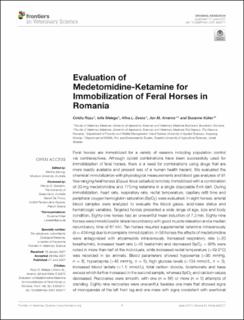| dc.description.abstract | Feral horses are immobilized for a variety of reasons including population control via contraceptives. Although opioid combinations have been successfully used for immobilization of feral horses, there is a need for combinations using drugs that are more readily available and present less of a human health hazard. We evaluated the chemical immobilization with physiological measurements and blood gas analyses of 91 free-ranging feral horses (Equus ferus caballus) remotely immobilized with a combination of 30 mg medetomidine and 775 mg ketamine in a single disposable 6 ml dart. During immobilization, heart rate, respiratory rate, rectal temperature, capillary refill time and peripheral oxygen hemoglobin saturation (SpO2) were evaluated. In eight horses, arterial blood samples were analyzed to evaluate the blood gases, acid-base status and hematologic variables. Targeted horses presented a wide range of age, size and body condition. Eighty-one horses had an uneventful mean induction of 7.2 min. Eighty-nine horses were immobilized in lateral recumbency with good muscle relaxation and a median recumbency time of 67 min. Ten horses required supplemental ketamine intravenously (x¯ = 434 mg) due to incomplete immobilization. In 58 horses the effects of medetomidine were antagonized with atipamezole intravenously. Increased respiratory rate (>20 breaths/min), increased heart rate (>45 beats/min) and decreased SpO2 < 90% were noted in more than half of the individuals, while increased rectal temperature (>39.0◦C) was recorded in six animals. Blood parameters showed hypoxemia (45 mmHg, n = 5), high glucose levels (>134 mmol/L, n = 3), increased blood lactate (>1.5 mmol/L), total carbon dioxide, bicarbonate and base excess which further increased in the second sample, whereas SpO2 and calcium values decreased. Recoveries were smooth, with one (n = 86) or more (n = 5) attempts of standing. Eighty-nine recoveries were uneventful, besides one male that showed signs of monoparesis of the left front leg and one mare with signs consistent with exertional myopathy. In conclusion, medetomidine-ketamine provided a reliable immobilization in feral horses over a wide range of body mass and age. However, based on the observed hypoxemia during immobilization, oxygen supplementation is strongly recommended for this protocol. | en_US |

